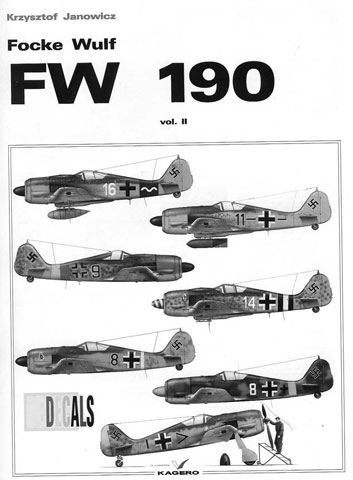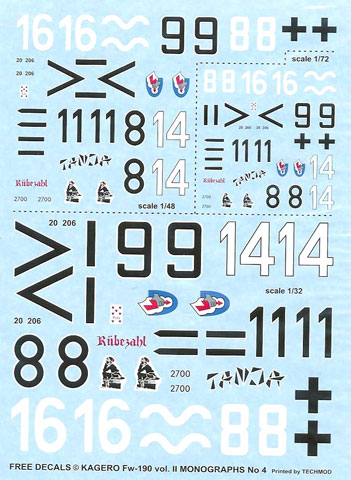S u m m a r y
|
| ISBN: |
83-89088-37-1 |
| Media: |
Soft cover, 112 pages of text
with 8 pages of line drawings, profiles of 24 individual aircraft
and a sheet of decals. |
| Price: |
USD$22.46 from Squadron Mail Order. |
| Review Type: |
First Read |
| Advantages: |
Polish and English text in
parallel columns. Decals in 1/72, 1/48 and 1/32 for 7 aircraft. |
| Disadvantages: |
Questionable facts |
| Recommendation: |
Recommended with reservations |
Reviewed by
Steven "Modeldad" Eisenman

Kagero's
Fw 190 Volume II is available online from Squadron.com
This second volume in
Kagero’s series on the FW 190 is more about the men who flew the FW190A
and the units that operated the aircraft, than it is about the aircraft
itself. For those who want to learn of the development of the FW 190A,
they should turn to Volume I.
In what seems to be
the Kagero style, this volume begins with a very dramatic, first person
account of a 190 pilot in combat. In this case it is Major Kurt
Bühligen of JG 2 during June of 1944.
The volume then goes
on to cover the use of the FW 190 on all fronts. The author begins with
the Western Front, then goes on to operations in Africa and the South
and North of Europe and concludes with the Ostfront (Eastern Front).
Within each section, the focus is on specific units that flew the 190,
and on specific pilots.
While the story flows
reasonably well, there are some bumps in the road. Just as we learn of
JG 2’s transfer from Italy back to France, the narrative abruptly takes
us to Norway, without warning. Also, Norway is “North Europe”,
with only a very cursory discussion of JG 5.
 The
combat story of the 190 is given its own drama. We hear of the
“aggressive FW 190” and how many Soviet aircraft were shot down in a
matter of a few minutes. Sometimes the story of the FW 190 tends to be
overwhelming. The author at various times has to pull back and remind
the reader that success is relative. By the time that we believe the
190 swept B-24s from the sky, the author notes, in one instance, that
the total US aircraft destroyed barely amounted to a week’s production,
and that the Luftwaffe suffered virtually irreplaceable loses of men and
machine. The
combat story of the 190 is given its own drama. We hear of the
“aggressive FW 190” and how many Soviet aircraft were shot down in a
matter of a few minutes. Sometimes the story of the FW 190 tends to be
overwhelming. The author at various times has to pull back and remind
the reader that success is relative. By the time that we believe the
190 swept B-24s from the sky, the author notes, in one instance, that
the total US aircraft destroyed barely amounted to a week’s production,
and that the Luftwaffe suffered virtually irreplaceable loses of men and
machine.
There is, however, a
problem that usually raises red flags of warning for me. That is the
use of unqualified facts, or facts that should be clarified or even
questionable facts. Often the uncovering of a little inaccurate
information may mean that there are other errors, which one may not
discover, or know about.
For example, in no
more than a parenthetical note on the night raiding activities of SKG
10, the author notes that the raids were conducted using A-4s. In fact,
SKG 10 used both the A-4 and A-5. This is like saying the USAAF 354th
FS used P-51B’s during 1944, and not mentioning the D model.
Some information may
be selective or incorrect. According to the author the first 190s in
Africa arrived on 21 November 1942 and were incorporated into JG 53.
This is nearly four months after the first 190s actually arrived,
assigned to EKdo 19, and days later than when III. / ZG 2 actually
received them. III. / ZG 2 was the first unit equipped with the 190 to
see combat.*
Other shorthanded
facts may cause confusion. The author notes that the aircraft of I. /
JG 51 were finished with two tone dark green 70/71 upper surface sprayed
in a ‘splinter’ type scheme. This leaves one with the incorrect
impression of a 1939 looking camouflage scheme. Where as, this was a
post-production application over 74/75/76. While this may seem petty, a
few more words of clarification would have gone a long way.
While on the subject
of camouflage, the author does not cover the subject at all. The
profiles present some quite eye-catching schemes and markings, some of
which raise questions. But, these are not discussed. There are two
quite interesting pictures of crashed 190s with a diagonal white (?)
stripe across the fin and rider that bisects the swastika. The caption
only states that this stripe characterized the aircraft of III. / JG
54. It is a shame that no other information is given about this strange
marking.
Speaking of pictures,
this volume is full of them. The problem is that they are not in any
particular order. It is a random jumble, with factory and structural
pictures interspersed with front line pictures. There is one great
picture, most likely created with a1940’s version of “Photoshop”, that
shows a 190 attacking a Spitfire. I won’t comment on the degree to
which the pictures are “unique’, as that all depends on how many
pictures of FW-190s a reader has previously seen.
Included in this
volume is a random assortment of reprints of technical documentation.
They are merely unrelated drawings of some aspects of various models of
the 190.
Finally, the bonus to
a Kagero purchase, the decals in 1/72, 1/48 and 1/32 scale, printed by
TECHMOD. In this volume there are markings for seven aircraft. As
usual, there are no national markings or swastikas
 1. FW
190A-8; Black 11. Lt Günther Heym; JG 51; Zichenau Airfield; Summer /
Fall 1944. 74/75/76. The name “TANJA” is blow the cockpit. 1. FW
190A-8; Black 11. Lt Günther Heym; JG 51; Zichenau Airfield; Summer /
Fall 1944. 74/75/76. The name “TANJA” is blow the cockpit.
2. FW
190A-5; White 8; IV. / JG 51; Eastern Front, Summer 1942; mix of greens
and browns. Yellow fuselage band and under-cowl.
3. FW
190A-8; White 16; 13. / JG 54; France; Summer ,1944; 74/75/76.
4. FW
190A-8; Black 9; II. / JG 301; Spring 1945; 75/83/76 with 81 mottle on
rudder; red and yellow defense band.
5. FW
190A-5; Black 8; 2 ./ JG 11; Husum Airfield, Germany; Summer 1943;
74/75/76 with a white fuselage band. “Kübelsahl” written below the
cokpit.
6. FW
190A-8/R8; Uffz. Oskar Bösch; Sturmstaffle 1;Salzwedel, Germany;
February 1944; 74/75/76.7. FW
190A-2; black “< + l”; Fw. Walter
Grünlinger; Stab. III. / JG 26; 1942; 74/75/76 with a personal emblem of
a seven of hearts playing card with the inscription “Rata’ on the card.
Yellow rudder and under-cowl. |
Home | What's
New | Features
| Gallery |
Reviews | Reference
| Forum
| Search